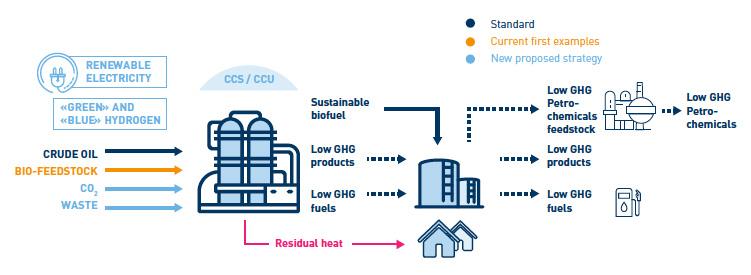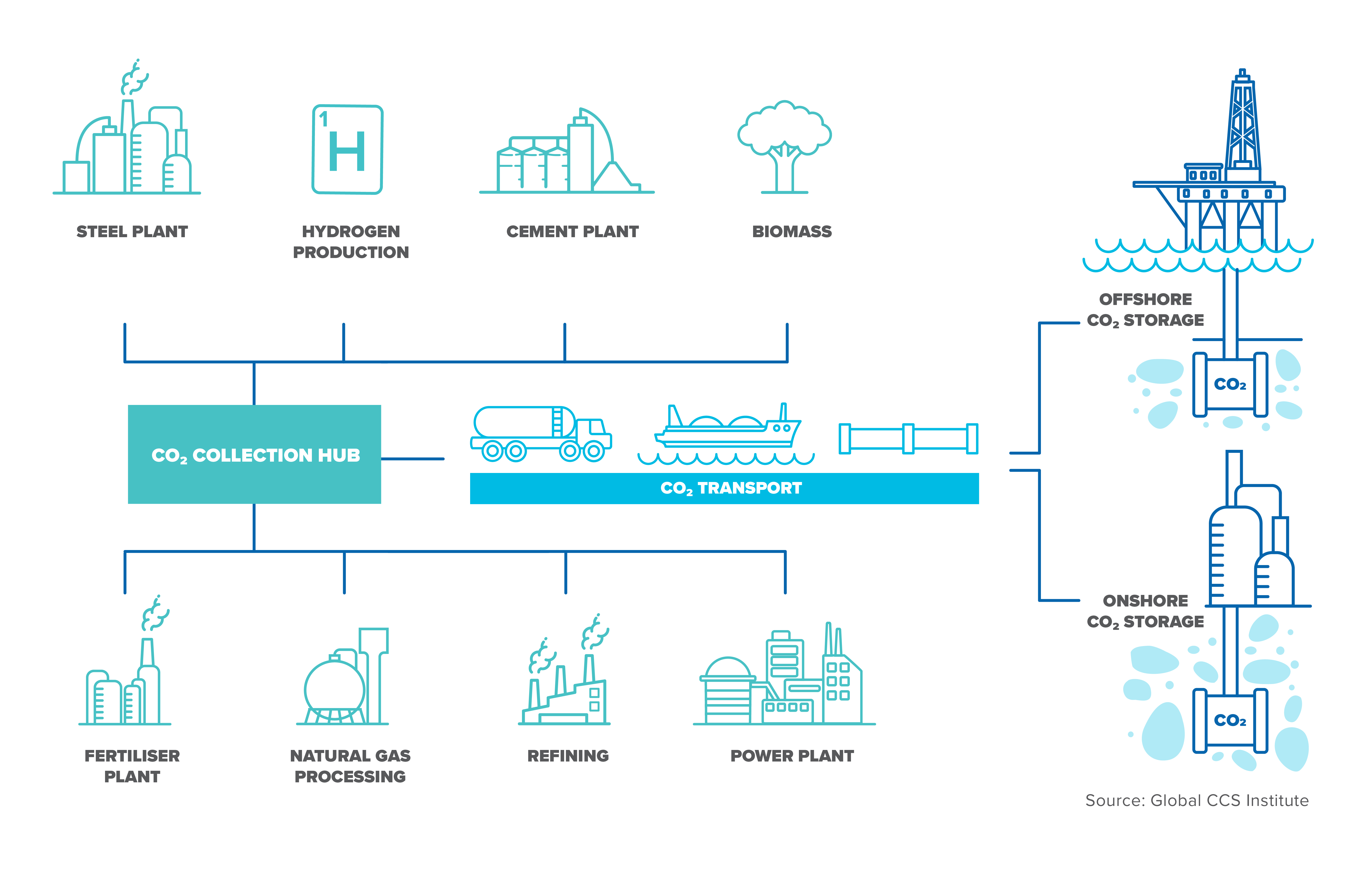Industrial Clusters

For big CO2 emitters, standalone CCS operations can make commercial sense. However, many industrial plants operate at smaller scales. Few refineries, for example, are large enough sources of CO2 to justify construction of dedicated infrastructure. Clustering, in which several facilities share CCS infrastructure and knowledge, can make CCS economically feasible.
The concept of industry clusters is well established in economic development and economic geography. Developing CCUS in clusters is increasingly viewed as key to accelerating uptake and most CCS projects in Europe are now planned as clusters and hubs.
These networks can also be made available for third party CO2 deliveries – as planned for the Northern Lights and PORTHOS projects, for example – thereby increasing economies of scale. Using a mix of transportation, including pipelines, ships, trains and trucks, can make a cluster accessible to other CO2 sources around it.
REALISE will help further these plans, working within a planned cluster in Cork, Ireland and developing two other business cases.
What defines hubs & clusters?
-
Multiple industrial point sources of CO2 connected to a CO2 transport and storage network.
-
Access to large geological storage resources with the capacity to store CO2 from industrial sources for decades.
-
Studies of almost all potential hubs and clusters have been supported by government.
-
Economies of scale deliver lower unit costs for CO2 storage.
-
Synergies between multiple CO2 sources and the storage operator reduce cross-chain risks and support commercial viability.
Source: Global CCS Institute
Industrial CCUS projects in Europe
-
Northern Lights – a partnership between our partner Equinor, Shell and Total to develop CO2 storage in the North Sea to support Norway’s plans for a fully integrated industrial project. CO2 will be shipped from multiple facilities across northern and western Europe. Builds on Norway’s experience of developing Europe’s only operational large-scale CCS facilities, the Sleipner and Snøhvit projects, the first in the world to geologically store CO2 offshore.
-
PORTHOS – Together with Northern Lights, The Netherlands’ Port of Rotterdam CCUS Backbone Initiative is Europe’s most advanced CCS project under development: a final investment decision is due in 2020-21 with a view to beginning operations by 2024. Also planned as open access transport and storage infrastructure, it has signed agreements with potential users, including Shell and ExxonMobil, which operate refineries and hydrogen production facilities in the port.
-
Zero Carbon Humber – Humberside, on the UK’s east coast, is an industrial centre with oil refining as well as steel, chemical and cement manufacturing. This cluster’s backers include Drax, the power company, and our partner Equinor. Plans include negative emissions bioenergy with carbon capture and storage (BECCS) at Drax and an Equinor hydrogen production plant, using natural gas, with carbon capture, which would be the largest of its kind in the world. Humberside can access storage sites in the North Sea, link into PORTHOS and share some infrastructure with Net Zero Teesside.
-
Net Zero Teesside – Teesside, also on the UK’s east coast, is another significant manufacturing centre, accounting for 5.6% of the UK’s industrial emissions and home to five of its top 25 emitters. A full-chain CCUS project, it hopes to become the UK’s first decarbonised industrial cluster. It is a European Project of Common Interest (PCI) backed by the Oil and Gas Climate Initiative’s CCUS kickstarter programme, as are Northern Lights and PORTHOS. BP is operator with ENI, Equinor, Shell and Total also participating.
-
Grangemouth/St Fergus – Grangemouth is Scotland’s chemicals and refining centre and its largest concentration of CO2 emissions, making it a candidate for a CCUS cluster. It has a pipeline to the St Fergus gas terminal, a natural hub for CO2 transport to storage in the North Sea, with potential to reuse existing offshore pipelines – plans that are being developed in Acorn, a PCI project. As a landing point for natural gas, hydrogen production with CCUS is also being planned at St Fergus.
-
Ervia Cork – this cluster, also part of a PCI, is central to REALISE which will test key technologies within it and use it as one of its three business cases. The proposed cluster centres on our partner Irving Oil’s Whitegate refinery and two gas-fired power plants. Like other European projects, it will rely on offshore CO2 storage, avoiding public opposition to onshore storage, and make use of existing oil and gas infrastructure, in this case the depleted Kinsale offshore gas fields. REALISE will also explore connecting it to PORTHOS and Northern Lights.
Enabling CCUS hubs & clusters
REALISE aims to formulate a sustainable, cost-efficient CCUS process that can be widely replicated. We will demonstrate our technologies at Irving Oil’s Whitegate refinery, Ireland’s only refinery and part of the Cork industry cluster. We will also develop CCUS business cases for Cork and two other clusters. The cases will examine full CCUS chains and how refinery-centred industrial clusters can connect to CO2 transport and storage infrastructure.
-
The Cork refinery is located next to the Whitegate and Aghada CCGT power plants, operated by our partners Bord Gais Electricity and ESB, respectively. Together these three entities form the Cork industrial cluster. Under Ervia’s Cork CCS project, both plants would have CO2 capture units fitted.
-
Being part of a cluster underpins REALISE’s “sector-coupling” strategy. Sector coupling involves linking power producers and consumers, enabling smart sharing of assets. Many refineries are located near industrial producers that can provide them with steam at relatively low cost and thus avoid the need for their own steam generation or combined heat and power (CHP) units, significantly lowering both capital and operating costs.
-
At Cork, the steam needed for CO2 capture at the refinery could come from the Whitegate power plant adjacent to it under our sector-coupling strategy. The aim is to capture CO2 continuously from the refinery stacks but only strip it from the solvent when steam from the power plant is available at low cost. As well as cutting costs, sharing resources also helps save space.
Sources
-
Delivering Clean Growth: CCUS Cost Challenge Taskforce Report July 2018, commissioned by UK BEIS. https://www.gov.uk/government/publications/delivering-clean-growth-ccus-cost-challenge-taskforce-report
-
Global CCS Institute: 2019 Status report and website https://www.globalccsinstitute.com/resources/global-status-report/
-
Oil and Gas Climate Initiative website including https://oilandgasclimateinitiative.com/oil-and-gas-climate-initiative-and-key-governments-crystallise-commitment-to-develop-a-commercial-ccus-industry-worldwide/
-
Company/project websites


